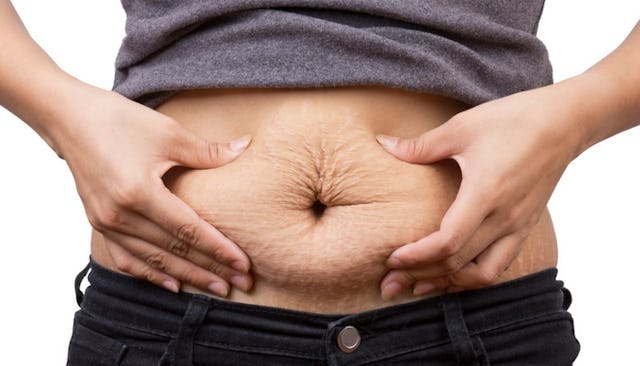How I Fixed My Own Diastasis Recti

For the last seven years, I have been trying to lose the baby fat from my first pregnancy. I have gone up and down in weight hitting desirable scale numbers but then bouncing right back up to those less than flattering numbers and all the while — no matter what I did — my belly still looked pregnant. There were days when it felt like I was dressing a beach ball because my shirts would ride up and my pants would ride down. This was annoying AF.
Turns out I had something called diastasis recti, which is a condition in which the abdominal wall separates leaving a gap. Not only does diastasis recti cause that awkward questions (“Are you expecting?”) but it also contributes, or sometimes even causes, that other awkward thing: peeing when you sneeze. This condition can be fixed with gentle exercises, physical therapy, and in some cases corrective surgery.
To figure out if I had such a gap, I simply laid flat with my knees up and my feet on the floor. With one arm behind my head, and lifting my head just enough to cause my abs to flex, I took my other hand and starting with one finger, gently pressed at the middle line slightly above my navel. That is when I felt the gap and was able to know exactly how bad it was. My gap was two fingers wide when I first tested myself. After 12 weeks of gentle movements, my gap is down to one finger wide.
Healing is slow.
Here is a video that I watched to help me figure out how to test for diastasis recti:
Once I realized that I had a problem with my abdominal wall and what it was, I was able to do a little bit of research to learn about how to heal it. Immediately I gave up lifting weights above my head, doing crunches, planks, and any workout move that required me to lift both feet off the floor or tense my abs.
When I got out of bed in the morning I learned how to make it habit to roll onto my side and get up sideways instead of straight up, this way I gave my abs a bit of a break while still engaging them.
I started to pay close attention to my posture, making sure that at all times I sat up or stood straight and pulled in my navel toward my spine to help re-engage my abdominal muscles in a gentle but effective way.
At night I did wall presses by standing in front of a wall with my hands out and feet hip-width apart, and I did what looked like push-ups against the wall. They certainly didn’t feel like I was doing much, but in fact, this was helping my gap shrink. Add to this gentle regimen walking — 10,000 steps a day was the goal — and squats, pelvic lifts, and gentle stretching and I was on my way to healing my midsection.
My gap is noticeably smaller, and as a result, my belly has begun to flatten out (finally) but I still have more work to do and need more time to heal. While it may be empowering to accept our postpartum bodies as beautiful instead of flawed, it is still important to know when something is potentially wrong. It’s also empowering to learn how to change them. I feel stronger, more confident in my skin, and that is damn near priceless.
(Ask your doctor what is right for you before embarking on any exercise program. Obviously.)
This article was originally published on